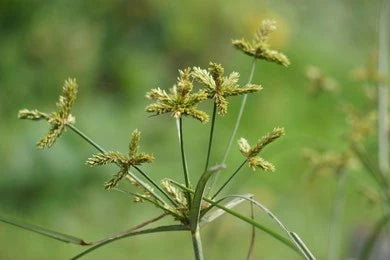Mustaka has been a part of Indian culture since ancient times. It had been extensively cultivated in ancient India. It's also known as Cyperus rotundus, which is its scientific name. It is also known as nut grass. Mustaka has a massive underground network of slender, creeping, and scaly rhizomes with bulbous bases that grow from a single tuber. This might range from 1 to 3 cm in length. The tubers are a dark brown color. These are oblong to ovate in shape and have a distinct smell. From the inside, these are red and white. The plant's stem is around 25 cm tall. The dark green leaves emerge linearly with a grooved upper surface and no ligules or auricles. The plant produces reddish-brown blooms. The Mustaka nut is yellow in hue, ovate, and oblong with three angles; when ripe, it turns black.
General Description
Mustaka has been cultivated in India since ancient times. This superbulb has been used to treat a variety of diseases. Mustaka's scientific and botanical name is Cyperus rotundus. This plant is in the Cyperaceae family.
It is frequently described in ancient books. Vagbhata uses this herb to treat fevers of all kinds. He also called it dipaniya (an appetizer) and pacaniya (a digestive). It is also revered by Maharishi Charaka as a thirst-quenching and anti-pruritic plant. It is native to India, although it is now found in a variety of temperate, tropical, and subtropical climates.
This plant has astringent, antispasmodic, antibacterial, demulcent, emmenagogue, analgesic, carminative, emollient, febrifuge, immune-stimulant, laxative, stimulant, tonic, vermifuge, anti-candida, anti-inflammatory, anti-diabetic, anti-diarrheal, cytoprotective, anti-mutagenic, antibacterial, and antioxidant properties.
The herb includes a number of chemicals such as components like Monoterpene hydrocarbon (like Limonene, p-Cymene, Camphene, Sabinene, α-Pinene and β-Pinene), Oxygenated monoterpenes derivatives (like α-Terpineol, Carvacrol, Borneol, 1,8-Cineole, Terpinen-4-ol, Myrtenol and Thymol), Oxygenated sesquiterpenes like (α-Cadinol, (2E,6E)-Farnesol, T-Muurolol, Elemol, α-Cyperone and Caryophyllene oxide.
Classification
- Kingdom - Plantae
- Subkingdom - Tracheobionta
- Super division - Spermatophyta
- Division - Magnoliophyta
- Class - Liliopsida
- Subclass - Commelinidae
- Order - Poales
- Family - Cyperaceae
- Genus - Cyperus
- Species - Rotundus
Habitat
Because of its capacity to adapt to a wide range of soil types, temperatures, soil pH, elevations, and moisture levels, it is widely dispersed. This plant forms tiny clumps up to 100cm tall. It is indigenous to India. Mustaka can be found across India, as well as in tropical and subtropical regions of Africa, southern Asia, and southern and central Europe.
Names of the Mustaka
- Sanskrit name - Mustaka, Raja Kaseruka, Abda, Krodeshta, Hima, Varida, Megha, Ambhoda
- Latin name - Cyperus rotundus
- English name - Java-grass, Coco-grass, Sweet Cyperus, Nutgrass, Purple Nutsedge
- Hindi name - Motha, nagarmotha
- Tamil name - Korai kilangu
- Telugu name - Bhadra-tunga-mustalu
- Manipuri name - Shembang kouthum
- Marathi name - Barik motha, Bimbal, Nagarmotha
- Malayalam name - Muttanga
- Kannada name - Tunge-gadde
- Gujarati name - Motha
- Bengali name - Dila Motha, Nagarmuta, Mutha, Badhail, Bedalle
- Oriya name - Mutha
- Bangladesh name - Motha
- Sri Lanka name - Kalanthi
- Swedish name - Nötag
- Thailand name - Yaa khon muu, Yaa haeo muu
- Turkish name - Topalak
- Urdu name - Habu-ul-zillam, Nagarmotha, Dheela, Mork, Motha, Sad kufi
- Assamese name - Keyabon
- Brazil name - Alho-bravo, Capim-dandá, Tiririca, Tiriricavermelha, Capim-alho
- Burma name - Monhnyin-bin
- Indonesia name - Teki
- Iraq name - Oyarslan
- Italian name - Cipero orientale, Cipero rotondo, Stancia, Zigolo infestante
- Japanese name - Hamasuge
- Mexican name - Cebollin, Pimientillo
- Myanmar name - Monhnyin-bin
- French name - Souchet à tubercules, Souchet rond, Souchet d'Asie,Herbe-à-oignon
- German name - Knolliges Zypergras, Rundes Zypergras
- Greece name - Kupere
- Peru name - Coquillo, Coquito, Coco
- Philippines name - Boto-botones, Balisanga, Mutha, Sur-sur, Mutha, Ahos-ahos
Ayurvedic Properties
|
|
Hindi / Sanskrit |
English |
|
Rasa (Taste) |
Kashaya, Tikta, Katu |
Astringent, Bitter, Pungent |
|
Guna (Physical Property) |
Ruksha, Laghu |
Dry, Light |
|
Virya (Potency) |
Sheeta |
Cold |
|
Vipaka (Post-Digestive Taste) |
Katu |
Pungent |
Effects on Doshas
It balances kapha and pitta.
Classical Categorization
|
Charak Samhita |
Sushruta Samhita |
Vagbhata |
|
|
|
Practical uses of Mustaka
- It has analgesic, astringent, antispasmodic, antibacterial, carminative, emollient, anti-inflammatory, anti-diabetic, and anti-oxidant properties, and other properties. It has an effect on a variety of diseases.
- Mustaka is used to treat skin conditions such as eczema, scabies, and itching.
- Helpful in the treatment of eye problems such as discomfort, redness, conjunctivitis, and ocular discharges.
- Helps to burn fat, which aids in the reduction of fat accumulation in obese people.
- Increases the size of the breasts.
- Normalizes menstruation problems such as irregularity.
- Improves digestion, eliminates toxins and worms from the GI tract, and purifies the blood.
- It is used to treat ulcers.
- It is a nerve relaxant that aids in the treatment of disorders such as psychosis, epilepsy, and mental health issues.
- Effective in situations of nausea, diarrhea, and dyspepsia.
- Controls the body's temperature.
- Asthma and cough are treated.
- Helpful in the pancreas, spleen, and liver pacification.
Parts Used
- Tuber
Dosage
- Decoction - 50 to 100 ml
- Powder - 3 to 6 grams

